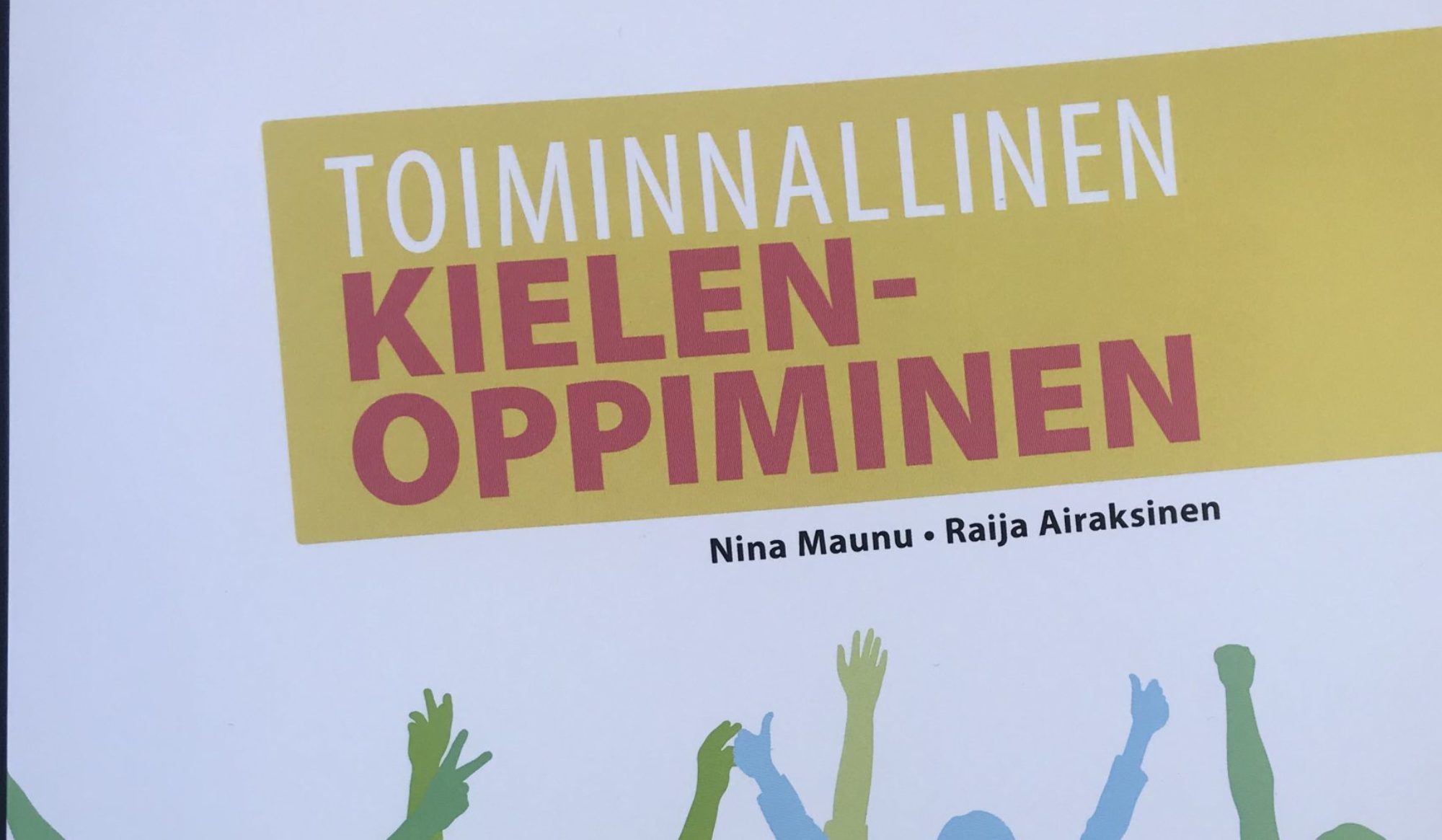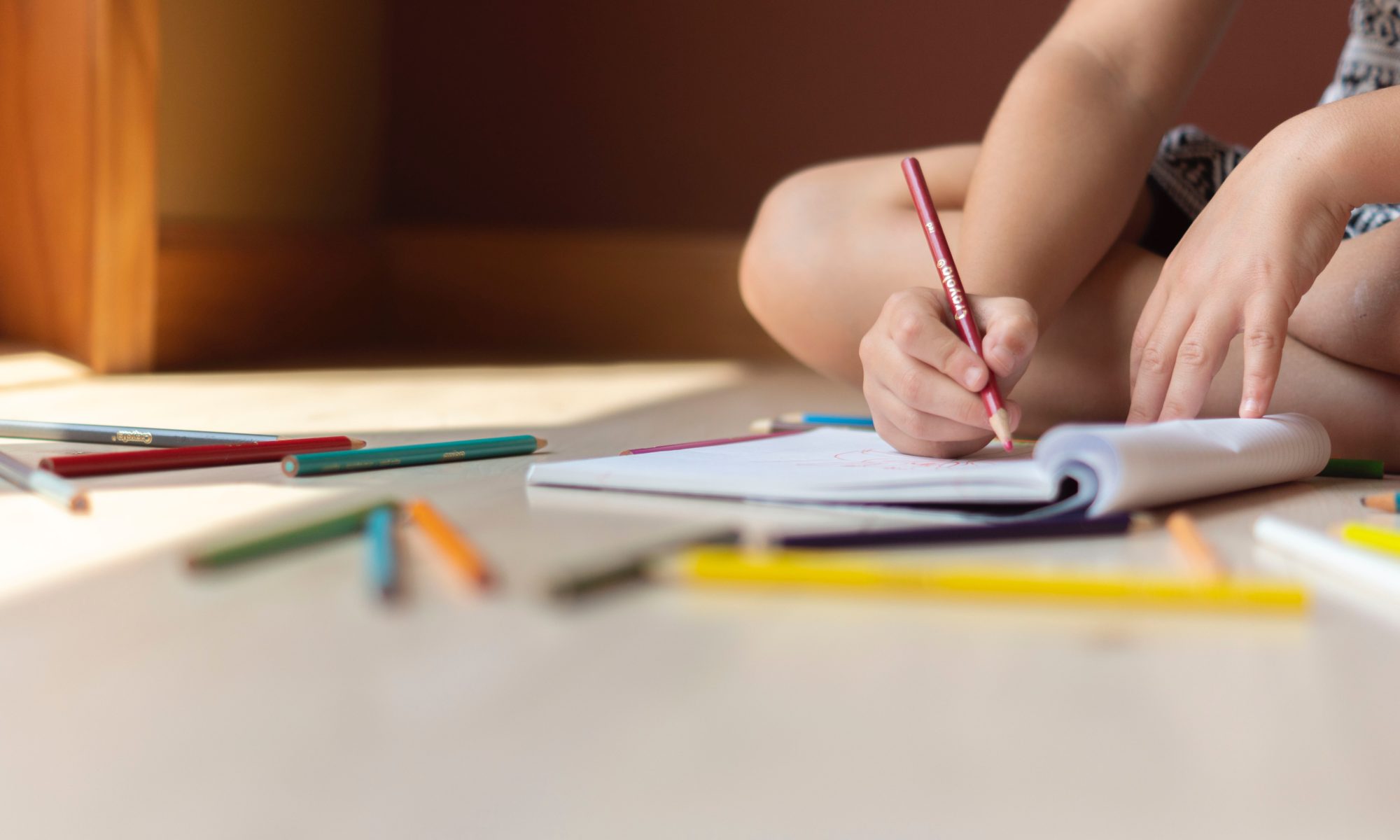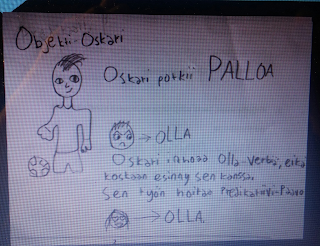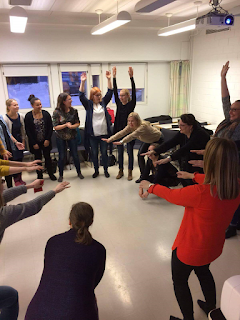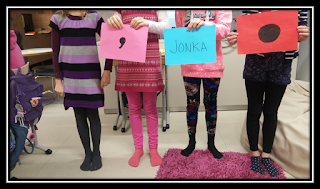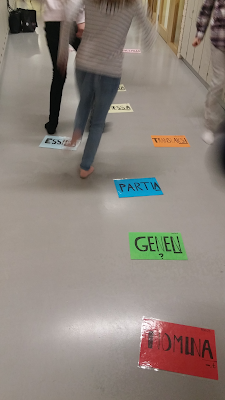Suuret kiitokset minun puolestani Natalia Kalloselle, ahkeralle ja innostuneelle opiskelijalle, joka kävi havainnoimassa Kilonpuiston koulussa muutamia 7. ja 8.luokan suomen kielen tuntejani sekä teki haastattelun, josta saamme tässä pienessä tutkimustyössä lukea. Työ on julkaistu Natalia Kallosen luvalla. Jostain syystä sisällysluettelo sekä tutkimuksen tarkoitusosio eivät suostuneet tulemaan tähän kopiooni tekstinä hyvin, joten jätin ne pois, myös kuvat.
Action-based Teaching Methods
Research project
Natalia Kallonen
Teacher as a Researcher
Actuality:
Facing the fact of our sedentary lifestyle and our “addiction” to all types of screens, it’s important to ask ourselves: What kind of activity do children need in the classroom? Besides new Finnish core curriculum emphasizes active, student-oriented learning, as well as drama, which is suggested to be a part of teaching in every subject (in one way or another), not to mention phenomenon-based learning and cooperation between the subjects. To reach this goal in education we must use a range of various methods, one of which is without any doubts action-based teaching.
Inspiration. Nina Maunu.
The choice of topic for this research wasn’t easy for me. I was completely lost until our lecturer said: “Just think what topic you are very passionate about.” And I was thinking, but not about a topic, I was thinking about a person that inspired me most. I first met Nina Maunu when I was having my basic practice in Kilopnpuiston koulu, she is the Finnish language and literature teacher. My mentor told me that Nina had been doing “magic” called “Toiminnallinen kielen oppiminen” during her lesson, I had no idea what it was, so I felt very intrigued and was looking forward to observing her lessons. Can you imagine studying the Finnish Grammar in the form of the game? Passing the ball to each other sitting in the circle, laughing and having fun, instead of doing boring exercises from the book? Can you imagine the lesson when all students are involved and eager to learn? And what about difficult grammar aspects turned into small theatre performances with the help of students and the teacher? If that’s hard to imagine, just come and see Nina’s lessons! Nina has been an active trainer of action grammar and action methods of teaching since 2011. She is also the founder of the Facebook group “Toiminnallinen kielen oppiminen”, which has over 8000 members.
When I started to work on this research project, I sent Nina the email asking for the interview and got the answer immediately, she was happy to meet and share her amazing experience. What a surprise it was when instead of an ordinary interview Nina suggested the walking interview, she explained later that walking interviews generate richer data, because interviewees are prompted by meanings and connections to the surrounding environment. Walking interviews give freedom, change from the meeting routine and innovative, new perspectives on the issue being discussed. When movement is involved our brain is stimulated differently, we generate new ideas more easily. And I agree with every word of that statement, it was a nice sunny day, we were walking in the forest discussing problems of action-based teaching methods and I can still recall every word I heard from Nina, that is amazing, and it works!
In our interview Nina touched upon such important topics as whether action-based teaching is suitable for teaching grammar, as well as if it’s good not only for kids but for teaching adults, as well as how action-based assessment works.
Nina says that her pupils love action-based activities, especially when learning grammar. Learning grammar is the organic and dynamic process of using language accurately, meaningfully and appropriately. It is a well-known fact that the mastery of grammar is a matter of dynamic use rather than static knowledge. And action-based methods help to build this dynamic use of grammar in a best way. According to Nina that that’s the most natural way of learning and applying the knowledge at the same time. One more positive side of this type of teaching is that students are not afraid of making mistakes, they know if they are wrong, they can start over again, it’s not a problem, there’s no pressure of a wrong answer. It makes atmosphere more relaxed and creates a safe learning environment for everyone. According to Nina not only children but also adults enjoy the opportunity when they are allowed to play and move during the lesson, it makes learning easy and fun, who would not like it?
One more important issue that we discussed was action-based assessment, it became a hot topic due to the new core curriculum, which emphasizes the importance of continuous and on-going formal assessment in the process of learning and teaching. Action-based assessment can be a “magic” tool helping to make the assessment process easier. Indeed, when the students are doing the exercise using movements, it’s so easy for the teacher to notice the level of the skills immediately. The topic of action-based assessment hasn’t been researched enough yet, but Nina is hoping it will be in the near future.
The connection between movement and learning.
“Tell me and I forget, teach me and I may remember, involve me and I learn.” Benjamin Franklin
This quotation by Benjamin Franklin illustrates the idea that the crucial point in teaching is involving learners in whatever there is to be learned. But isn’t it easy said than done? Well, first of all, we should bear in mind that in order to truly involve learners in the learning process, they will have to be able – and to be allowed – to respond to a topic from their own point of view. They will also have to be able to engage with others in a constructive way (Bonnet, 2007, p.134). So, our task as foreign language teachers is to enable learners to become engaged in meaningful interaction in a foreign language regarding topics and problems posed by the curriculum of the subject.
Isn’t it astonishing that the dominant model for formal learning is still “sit and git”? It can partly be justified by the high status of conventional academic work, which associates intelligence mainly with verbal and mathematical reasoning. But is it really so? On the one hand, for decades, scientists seemed to believe that thinking was thinking, and movement was movement, and each was as separate as could be. But on the other hand, there had been changes in the works of the major giants of educational thought like the Swiss educator Johann Pestalozzi, Jean Piaget and Lev Vygotsky. If we look at their works, we can notice that there is a clearly discernible trend over the last hundred years or so to recast pedagogy in action-based, whole-body, experiential terms. The works of those educational scientists help us understand that the learner is a whole person, not an input-processing brain that happens to be located inside a body that should preferably sit still while the input is transmitted, received and computed by the brain. Our task is to see a human being as a whole, where the body is the center of existence and also center of perception and learning.
Researchers argue that even though it seems that brain controls the body, thinking is not independent of the body but instead closely bound to it and also enabled by it. Strong evidence from different sources (anatomical studies, and clinical data) supports the connection between movement and learning. The first evidence of a linkage between mind and body was scattered in various proposals over the past century. Today, the evidence has become a groundswell, and most neuroscientists agree that movement and cognition are powerfully connected. The area of the brain most associated with motor control is the cerebellum. It’s located in the back of the brain, just under the occipital lobe, and is about the size of a small fist. The cerebellum takes up just one-tenth of the brain by volume, but it contains nearly half of all its neurons. In fact, it has some 40 million nerve fibers. Those fibers feed information from the cortex to the cerebellum, and they feed data back to the cortex. Amazingly, the part of the brain that processes movement is the same part of the brain that processes learning (see picture below).
When movement is involved, the brain is stimulated differently than when someone is passively listening or watching, so movement elements are essential elements in learning as they refer both to actual movement and to inner sensations and experiences within a person’s body, and to physiological changes due to the movement. It’s worth mentioning that bodily experiences are crucial for the development of conceptual knowledge. Concepts are constructed with the same neural systems as moving and perceiving and because concepts are the tools for thinking, they are largely born through bodily, motoric processes.
So we can make a conclusion that learning and movement are interconnected and one is helping another.
Learning and playing.
Learning is equivalent to making sense. The aims of learning are understanding and giving meaning to experience. There are infinitely numerous ways of experiencing the world and giving meaning to it (e.g. from various perspectives or affective states). We can make a conclusion that learning as an active, cultural process embedded in human interaction of making meaning. How to enrich the learning and contribute to make it enjoyable, which is synonymous to making it deeper and more sustainable (especially in vocational and adult education)? To answer this question let’s remember George Bernard Shaw words: “We don’t stop playing because we grow old; we grow old because we stop playing.” What if games came in as a rightful and equal partner in the learning process? Game place both children and adults on a continuum where learning is constant and goes hand in hand with pleasure. Game can therefore be seen as a preparation for adult life, a simulation of work that is free of real risk and hence promotes experimentation and creativity while conserving a sense of discipline and a quest for achievement.
Especially in the form of simulation, game requires participants to momentarily accentuate their natural inclination towards observing, exploring and imitating. The fundamental mechanisms of learning, namely, assimilation and accommodation, are thus put into action and keep working as long as fresh stimuli are fed into the players’ perception. We can make a conclusion that in the light of this consistent bond between playing, working and learning, games are revealed as a valuable educational tool whose full potential has thus far gone unexploited in the school system. On the one hand, games entertain students, but on the other hand, they give them a strong sense of fulfilment every time they meet each challenge, especially as they have to do so using a foreign language. This combination of fun and success motivates students to keep improving and to participate more actively in class activities. Body movement is the central of the game and has to operate in conjunction with the spoken word.
Learners interact with each other during the game and their visual, auditory and kinesthetic channels are constantly alert and ready to receive new input. It makes learning more effective and comprehensive, as all senses are being activated. Games are governed by rules that need to be followed. Students not only draw pleasure and motivation from the playful side of the activity, but also learn to frame their behavior and performance within certain parameters without feeling restricted. Games performed in a foreign language set a multiple challenge for people who suffer from insecurity and self-unconsciousness, they gradually overcome the fear of expressing and exposing themselves in front of others due to the appeal of the games, the support of their teams and the sense of fulfilment they draw from reaching their goals. Not to mention the team work. Students need to help each other, to compromise and to adapt in order to reach their collective goal. They perceive information, come up with ideas, express themselves and interact with each other in the target language. By playing their assigned roles in specific, if simulated, communicative situations, they internalize cultural and pragmatic elements that are key to a comprehensive grasp of the foreign language. Summing it up, we can clearly see the benefits of using games in teaching and learning process.
Benefits of using Action-based Teaching Methods.
Among the most important benefits of using action-based teaching methods are the following:
- Creating positive atmosphere during the lessons.
- Reducing the stress level.
- Helping to develop social skills.
- Helping to develop self-esteem.
- Increasing of motivation.
- Helping to develop memory.
Now we would like to discuss all those factors more precisely.
Creating positive atmosphere during the lessons.
It goes without saying that learning environments where movement is integrated allow students to learn in a more enjoyable context. Students love being there, they academically perform better, and the information needs less review because students retain the content more efficiently. And as we know, creating a positive and safe atmosphere is one of the most important thing that teachers should take into account if they want to reach the goal of effective learning.
Reducing the stress level.
On the contrary with the previous paragraph, if students are uncomfortable or stressed their brain will not retain new information easily, especially when critical thinking skills are being relied upon or the student is needing to connect new information to their personal experiences, prior knowledge or abstract thought. Action-based teaching methods can help restore joy and stability in troubled lives, reduce restlessness among antsy learners, and ease the tensions in schools. This all happens due to the fact that movement give kids the chance to release stress. To sum it up,incorporating exercise and movement throughout the school day makes students less fidgety and more focused on learning, not to mention improving on-task behavior and reducing classroom management challenges. These are among the most obvious benefits of adding physical activities to the process of learning.
Helping to develop social skills.
One of the biggest advantages of using action-based teaching methods is the fact that it has important benefits for students’ social relationships, particularly among genders and age groups. It also aims and to enrich the culture of the schools by cultivating collaboration, respect and compassion. It helps to create and promote interaction and collaboration in the classroom, but this is not all, it also helps to develop emotional maturity and skills to cope with both success and failure, encouraging students to act, interact, cooperate and compete. Students are expected to have internalized the dynamics of team work, the need to help each other, to compromise and to adapt in order to reach their collective goal faster and more efficiently.
Helping to develop self-esteem.
There is a positive association between physical activity and self-esteem and self-concept. Physical engagement helps children build the foundations of their self-esteem, especially for children who are naturally shy or have difficulty with certain developmental areas. Kids can learn empathy by sharing and build self-esteem and leadership skills by working as part of a team. Physical engagement also enables students to take ownership of their learning and develop presentation skills.
Increasing of motivation.
It goes without saying that using action-based teaching methods generates energy, enthusiasm and motivation.
Helping to develop memory.
Action-based teaching methods improve memory, concentration and positive outlook. That happens because when our brains receive input from our visual, tactile, auditory and olfactory senses, it allows us to engage with the rest of the world.That means that incorporating activities that involve all the senses make learning more memorable.
In conclusion it needs to be said that everything mentioned above demonstrates that that movement can be an effective cognitive strategy to strengthen learning, improve memory and retrieval, and enhance learner motivation and morale.
Conclusion.
In conclusion of the theoretical part we would like to say that some of the smartest things teachers can do are the simplest, when we keep students active and engaged, letting them move around, use their body language in learning and exploring the world, we keep their energy levels up, as well as their curiosity and activeness, needed for the highest performance. Joy of learning is not measurable on tests and exams, intelligence and creativity develop as students explore the world, figuring out on their own how things work. To make this goal of effective education true, we should pay our attention to active-based teaching methods. A creative teacher is the one who sees endless ways to bring more excitement into their lessons and is not afraid to try something new, and the students will love him/her for it, let’s be those creative teachers, let’s make a difference!
References.
Aittasalo, M. 2013. Lisää liikuntaa vai vähemmän istumista koulupäivään?UKK-instituutti.
Biddle, S. J. H. 2000. Emotion, mood and physical activity. S. J. H. Biddle, K. R. Fox & S. H. Boutcher (toim.) Physical activity and psychological wellbeing. London: Routledge.
Bonnet, A., and Dalton-Puffer, C. (2013). Great Expectations? Competence and Standard Related Questions Concerning CLIL Moving into the Mainstream. In S. Breidbach & B. Viebrock (Eds.), Content and Language Integrated Learning (CLIL) in Europe. Research Perspectives on Policy and Practice, (pp.269-284). Frankfurt/M.: Lang.
Chaddock-Heyman, L., Erickson, K., Voss, M., Knecht, A., Pontifex, M., Castelli, D., Hillman, C. & Kramer, A. 2013. The effects of physical activity on functional MRI activation associated with cognitive control in children: a randomized controlled intervention. Frontiers in human neuroscience 7 (72), 1–13.
Christin Müller Marco Schroeder, 2015. Content and Language Integrated Learning Inspired by Drama Pedagogy. GERMANY Zukunftsbau GmbH (Coordinator)
Cooper, Paul & Jacobs, Barbara 2011. From inclusion to engagement. Helping students engage with schooling through policy and practice. Chichester: WileyBlackwell.
Dewey, J. 1938. Experience and education. New York: The macmillan company.
Grissom, J. B. 2005. Physical fitness and academic achievement. Journal of Exercise Physiology, 8,11-25.
Ilveskoski, L. 2013. Motivaatiota leikkien. Toiminnallisen oppimisen vaikutus oppilaiden motivaatioon. Tampereen yliopisto. Opettajankoulutus laitos. Pro gradututkielma.
Kantomaa, M. & Lintunen, T. 2008. Henkinen hyvinvointi ja oppiminen. Teoksessa Fyysisen aktiivisuuden suositus alle kouluikäisille 7 – 18-vuotiaille 2008. Lasten ja nuorten liikunnan asiantuntijaryhmä, Opetusministeriö ja Nuori Suomi, 79–81.
Kolb, D. A. Experiential learning. 1984. Experience as the source of learning and development. New Jersey, Englewood Cliffs: Prentice-Hall.
Morgan, W. 1997. Physical activity and mental health. Washinton, DC: Taylor & Francis.
National Core Curriculum for Basic (2014). National Core Curriculum for Basic Education. Helsinki: National Board of Education.
Pfeifer, R. & Bongard, J.: How the Body Shapes the Way we Think: A New View of Intelligence. Cambridge: MIT Press, 2007
The Finnish national board of education, Objectives for the Finnish curriculum 2016, [www-page]: http://www.oph.fi/ops2016/tavoitteet. Referred 24.6.2015
